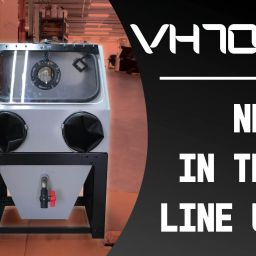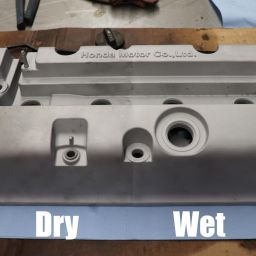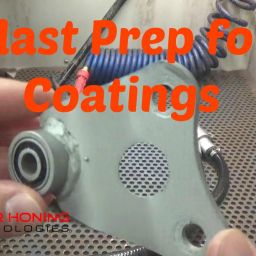Vapor Honing Abrasives: Here’s How It Works
You can refinish a variety of services with vapor honing. However, it’s helpful to understand how to choose the right abrasive media for the job.
Vapor honing looks a lot like sandblasting. The only obvious difference is that operators use water in the process. However, vapor honing and sandblasting are quite different.
For example, you can use a range of abrasive and nonabrasive materials for vapor honing, which is also called wet blasting. These materials might include ceramic beads. Alternatively, an operator might use a glass or plastic abrasive media.
To learn more about vapor honing abrasives, read on.
Understanding Vapor Honing Abrasives
Vapor honing involves the use of water and an abrasive compound. Together, these components form a slurry. Meanwhile, vapor honing equipment propels the slurry using compressed air.
When choosing an abrasive compound, it’s important to consider factors such as desired surface roughness. Alternatively, the aesthetic finish might serve as a much more important characteristic for your needs.
It’s important to understand that vapor honing cleans with flow pressure. Alternatively, sandblasting cleans via impact.
For this reason, operators can use vapor honing to refinish or clean surfaces using the finest abrasives. For some applications, you can even use 1,200 mesh abrasives.
Vapor honing is a dust-free alternative for refinishing surfaces. The process also doesn’t involve the use of harsh chemicals.
Benefits of Vapor Honing
With vapor honing, you can perform two tasks at once. For example, you can smooth and degrease a surface in one easy step.
You might consider using a vapor honing system for remanufacturing. Alternatively, you may want to use the process for the finishing stages of CNC machining. You can even use vapor honing to prepare surfaces for painting.
Vapor honing is a flexible procedure. For this reason, you can use it for a range of applications. This reason is also why a growing number of firms are choosing vapor honing over sandblasting.
Today, you can select vapor honing equipment with a number of added features. For instance, you can equip your system with a media density meter.
Alternatively, you can purchase a system with custom LED lighting. You can also buy a system with a heated sump. Furthermore, you can choose a vapor honing system with manual turntables.
Vapor Honing vs Sandblasting
If you’re considering vapor honing as a replacement for sandblasting, you’ll want to know more about the difference between the two processes.
Some operators also call vapor honing “water blasting.” As the name suggests, vapor honing involves using water to clean and refinish a surface.
During the process, a vapor honing system deploys high-pressure water in a concentrated stream. The stream projects from a handheld nozzle.
It washes away all debris and particles. The stream also removes any existing coatings.
Vapor honing is an eco-friendly finishing solution. There are no chemicals involved in the process. For this reason, operators don’t have to worry about chemicals releasing into the air and the environment.
Nevertheless, vapor honing systems are high power devices. For this reason, it’s important to exercise care when working with wet blasting equipment.
At the same time, vapor honing is ideal for sensitive projects. The system allows you to adjust for lighter pressure or a stream with a wide radius as needed.
Selecting Value-Added Features for Vapor Systems
Most vapor honing systems include a built-in dry vac system. Even without this feature, however, the remnants of the process are easy to clean up. You can simply let any water left behind air dry.
On the other hand, sandblasting uses abrasive media. Sandblasting is also a high-pressure system.
Despite the name of the process, you wouldn’t want to use silica sand to refinish a surface. An abrasive material with the harshness of silica sand would destroy nearly any project.
Sandblasting is remarkably fast. It involves combining high-pressure air with abrasive material.
However, the process generates considerable clouds of dust. The dust presents health hazards and creates an unsightly mess.
Types of Vapor Honing Media
Every vapor honing procedure involves the use of water. However, you can select different honing media to achieve varying results.
A huge benefit of some vapor honing systems is that they support a closed-loop rinse. You can also dry parts in the same container with some systems.
Some systems even support drying pass Millipore testing. Millipore testing is a common method used for testing part cleanliness. In this way, you can eliminate the need for multiple pieces of equipment.
Still, you’ll need to choose the right abrasive material for your application. The following overview may help you to decide.
Round Vapor Honing Media
Round vapor honing media is a popular choice among operators. It’s available in ceramic.
You can also purchase vapor honing round media in glass beads and stainless-steel shot. Round media works well with a variety of vapor honing systems.
With round vapor honing media, you can clean various surfaces thoroughly. The material leaves surfaces clean and bright. It’s also ideal for descaling.
As an example, medium-sized round vapor honing media provides considerable blasting power. For this reason, it works well for applications such as smoothing and stripping paint. Also, it doesn’t damage the surrounding surfaces.
For extra sensitive jobs, you can adjust the water flow or volume. At the right setting, round abrasive media leaves a smooth finish. It also provides mild peening benefits.
Plastic Angular Vapor Honing Media
Plastic angular vapor honing media is an abrasive material frequently used by operators. You can also use this media for paint stripping. Furthermore, it works well for deflashing and removal of plastic components.
For example, you might use plastic angular vapor honing media as part of a system. Your cleaning system might include blasting a part with abrasive material, then plain water. Next, you’d finish the part off with a dryer.
Plastic angular vapor honing media provides a more aggressive abrasiveness. You may use this kind of media for cleaning new machine components for automotive or aviation applications.
Alternatively, you might use this media for working on marine or semiconductor parts. You can also use plastic angular vapor honing media for deburring.
This kind of media is well-suited for engine rebuilding. For example, you can use a coarse grit to remove heavy scale. You can also use it to remove rust.
Also, you can use plastic angular vapor honing media to remove light soiling. It’s also ideal for degreasing parts.
Angular Grit Vapor Honing Media
Angular grit vapor honing media is yet another option for vapor honing. It’s a highly aggressive material.
For this reason, angular grit vapor honing media works well for blasting hardened surfaces. It’s ideal for heavily rusted or greasy surfaces. Angular grit vapor honing media also works well on heavily scaled surfaces.
You might use angular grit vapor honing media made of steel grit. Alternatively, you might select abrasive material made of crushed glass. You can also purchase angular grit vapor honing media made using aluminum oxide and silicon carbide.
Fine Angular Grit Vapor Honing Media
With fine angular grit vapor honing media, you can clean deep into surface pores. You’ll often see operators use this media in avionics. Technicians use fine angular grit vapor honing media for cleaning new and used jet engine components.
They also use it for exposing cracks in critical parts. By cleaning parts using vapor honing, technicians can conduct liquid penetration inspections.
Fine angular grit vapor honing media delivers a clean, roughened, and even finish. However, it has fewer low valleys and high peaks compared to conventional sandblasting.
Resultantly, operators need less resin to fill in voids. Materials treated with fine angular grit vapor honing media also provide superior bonding characteristics.
You can also use fine angular grit vapor honing media to remove contaminants. For example, operators may use fine angular grit vapor honing media for prepping surfaces. They’ll use the material to prepare various objects for a protective coating or painting.
Vapor Honing: A Better Way to Refinish Surfaces
Today, vapor honing is one of the most versatile blasting processes in the world. The process suspends abrasives in the water. This characteristic changes the process of blasting materials compared to dry blasting.
For this reason, operators can use a vapor honing system to safely polish metals. They can also use it to strip coatings.
Alternatively, you may want to use a vapor honing system to prepare a surface for new coatings. Then again, you might need a vapor honing system simply to degrease parts. Either way, the latest vapor honing equipment makes refinishing surfaces considerably easier compared to sandblasting.
Still, there are more benefits to vapor honing. For instance, the process combines tasks. This benefit is what makes vapor honing so unique.
Furthermore, vapor honing is virtually dust-free. The process produces little dust because water contains the abrasive materials.
Doing More With Vapor Honing
A vapor honing system can help you to expedite the cleaning process. It’s faster, yet it washes away any contaminants gently. At the same time, there’s no need to worry about embedding abrasive materials into the surface of your components.
Vapor honing also eliminates excessive heat and friction. It’s a relatively straightforward process. As long as you choose the right abrasive material and equipment, you’ll achieve satisfactory results with every application.
There are a few videos around about building DIY vapor honing systems. For this reason, you may have considered saving on vapor honing cabinet cost by building your own system.
It’s important to understand that not all vapor honing systems are the same. It takes years to develop a honing system for effectively mixing abrasive materials and water.
It also takes considerable time to engineer and construct a system that can stand up to commercial use. If you only need to refinish or smooth surfaces occasionally, you’re better off looking for vapor honing services.
Successful vapor honing requires two important components. It’s important to work with quality equipment.
However, it’s equally important to choose the right abrasive compound. An experienced supplier can help you to figure out the ideal system for your application.
Selecting the Right Abrasive
You can choose from a range of abrasive materials. For example, you may consider glass bead abrasive material.
This abrasive is ideal for producing a satin finish. For this reason, it’s a good fit for creating an OEM finish on parts. Glass bead abrasive media also works well for finishing CNC parts.
You can also use glass bead abrasive material for cleaning injection molds. This material is also a good abrasive for general-purpose cleaning. For this reason, it’s often used for motorcycle and automotive restoration.
Alternatively, you might make use of brown aluminum oxide abrasive. This material works well for deburring machine parts. It’s also another good material for CNC parts smoothing.
Furthermore, brown aluminum oxide abrasive powder does a great job of removing coatings and other similar finishes. For this reason, it’s ideal for preparing a surface for a new coating.
Ceramic bead abrasive is also another popular vapor honing material. It also does a good job at creating an OEM quality finish. You might select this material for heavier CNC tool parts smoothing.
This abrasive material has a heavier bead. For this reason, it cleans faster.
It also lasts longer than traditional glass beads. Accordingly, restoration professionals use this material frequently.
Finally, you may consider Garnet abrasive material. This abrasive is another great option for deburring machine parts. Likewise, it’s also ideal for CNC parts smoothing and preparing surfaces for painting.
Choose a Trusted Supplier for Quality Vapor Honing Equipment
Now you know more about vapor honing abrasives. What you need now is a supplier who can help you to find the right balance of vapor honing equipment and abrasive materials.
Vapor Honing Technologies has served commercial refinishing needs for nearly ten years. We’ve helped companies across a range of industries accomplish their refinishing goals.
You can trust us to find the perfect solution for your application. Furthermore, you can count on us to provide you with competitive vapor honing equipment.
At Vapor Honing Technologies, we’re proud to offer vapor honing equipment made in the USA. Also, we back our equipment with a lifetime warranty.
Contact Vapor Honing Technologies today at (828) 202-5563 or connect with us online to find out more about boosting your output and cutting operational costs.








